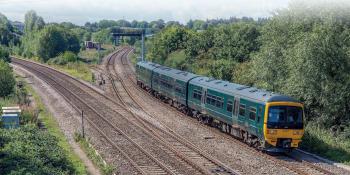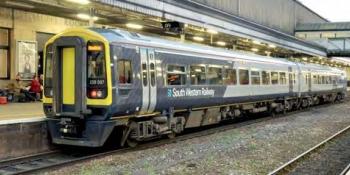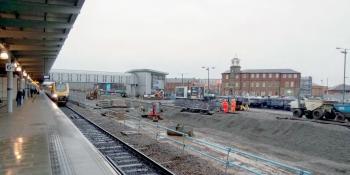EUROPE
DELLE TO BELFORT SERVICES RESUME
On 9 December the line between Delle on the French/Swiss border and Belfort in France reopened to passenger services after 26 years. On the French side the line has been completely rebuilt and electrified with three intermediate stations; on the Swiss side local services had served Delle from Switzerland during the period the French section of the line was closed.
Services are being operated in what can only be described as a strange way, with SBB-operated dual-voltage Flirt EMUs offering a two-hourly service between Biel and Meroux TGV, which is the name given to the regional platforms that cross the high-speed line at Belfort Montbéliard TGV station (despite the different station names interchange to the high-speed platform is a two minute walk!). From Meroux a connecting service operated by SNCF is provided for some but not all SBB trains to Belfort itself, only around 7km away; this section of the route reopened when the LGV Rhin-Rhône opened in 2011. The ‘logic’ as reported by some local media for this overly complex service appears to be a desire among some on the French side of the border to avoid Swiss Stadler-built trains reaching Belfort, the home to a major Alstom plant (itself threatened with closure in recent years so a very emotive local political topic).
EXTRA ICEs TO BRUSSELS
Deutsche Bahn is planning to increase the number of ICE services between Frankfurt/ Köln and Brussels to seven train pairs daily on weekdays (six train pairs at weekends) from April The new timetable will include late evening services in each direction arriving at Brussels at 23.35 and eastbound at Köln at 20.25 (from where a guaranteed connection to Frankfurt will be provided). The new services should increase journey opportunities for travellers to and from London using Eurostar services to Brussels.
The Frankfurt to Brussels service is operated using DB Class 406 quadri-voltage ICE3M EMUs dating from 1997. These appear to suffer serious reliability problems on the route, which entails multiple changes of traction current and signalling systems between Brussels and Aachen; well-rehearsed contingency arrangements are regularly used to turn trains short of Brussels at either Düren in Germany or Liege in Belgium.
DENMARK
GREAT BELT ACCIDENT KILLS EIGHT
Eight passengers on-board a train on the Storebalt (Great Belt) route in Denmark were killed and 16 injured on 2 January when an IC4 DMU was struck and seriously damaged by debris, believed by investigators to include a loose road HGV semitrailer from a passing freight train, on one of the Storebalt over-sea bridges in extremely high winds.
The Storebalt or Great Belt Fixed link comprises two long bridges, totalling 13.4km, connected by an 8km-long rail tunnel crossing part of the Baltic Sea – the Storebalt strait between the Danish islands of Zealand and Funen. It opened in 1998, replacing train ferry routes that previously connected the islands. The rail line on the link forms part of the main route between the Danish capital Copenhagen and western Denmark. It also forms part of the freight route connecting Germany with Denmark and Sweden.
The freight train involved, operated by DB Cargo, carries road semitrailers loaded with empty beer crates up to 30 times a week and has been operating for several years without any previous problem. There were 131 passengers and crew on-board the passenger train; early reports suggested only minor injuries, but Danish police had confirmed multiple deaths within a few hours. The accident and storm force winds forced the closure of the route. DB Cargo announced the suspension of the ‘beer train’ conveying semitrailers following the accident, saying it would not run again until the cause was known and if necessary mitigated.
Investigations by Danish police and accident investigators have led to the conclusion that one or more trailers was not securely fastened in the type Sdggmrs ‘pocket wagons’ they were being carried on. The high winds at the time, which disrupted land and sea transport across a wide arc of north west Europe on 2 January, may have led to the loose trailer being moved into the path of the passenger train. As a precaution, Danish transport safety body Trafikstyrelsen issued a prohibition on the use of ‘pocket wagons’ on the Danish network on 8 January pending independent safety checks and verification for all operators wishing to use them, especially of the king pins that hold trailers in place in the wagon (effectively replicating the arrangement when the trailer is moved by road attached to a HGV tractor unit).
In addition to domestic traffic such as the Carlsberg ‘beer train’, multiple transit freight trains cross Denmark daily from Germany to Sweden and Norway, some of which utilise ‘pocket wagons’. Trafikstyrelsen also introduced new operating rules for freight trains using the Storebalt route, restricting them to 80km/h in strong winds and prohibiting high-sided freight train use in gale conditions over Force 8 (39 knots) and all freight movements in winds over storm Force 10 (49 knots).
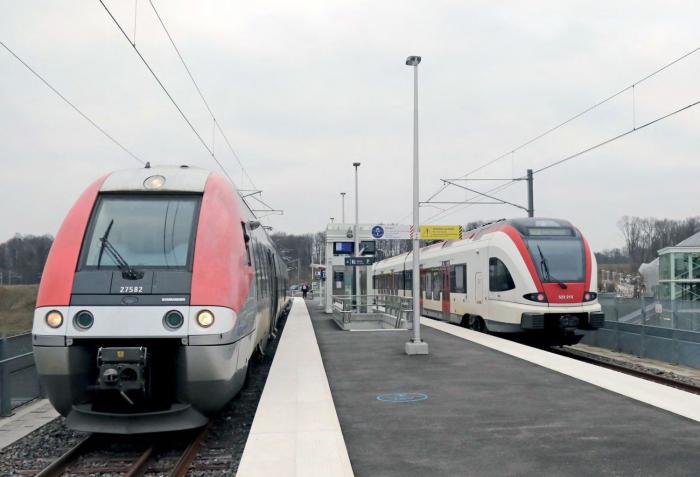
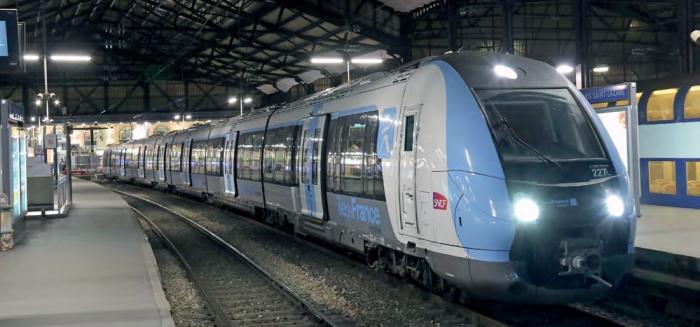
FRANCE
TWO ORDERS FOR BOMBARDIER FROM FRENCH REGIONS
In late 2018 Bombardier received two orders based on earlier framework contracts. In December French Railways (SNCF), on behalf of the Greater Paris public transport authority Île-de-France Mobilités, ordered 47 additional ‘Francilien’ EMUs at a cost of €330 million. These will be supplied as 5x8-car and 42x7-car trains for use on lines L, J (Paris St Lazare – Cergy le Haut/Mantes le Jolie and other destinations) and P (Paris Est outer-suburban routes) on the SNCF Transilien network. The original 2006 contract for ‘Francilien’ trains allowed for up to 372 to be ordered; with this order the fleet has grown to 360 trains, all of which should be in service by 2022. The trains are assembled by Bombardier at its Crespin plant near Valenciennes.
In November Bombardier received a €256 million order on behalf of the Hauts-de-France region for a further 19 Omneo Premium part double deck articulated EMUs to operate services between Paris Nord and Maubeuge/St Quentin/Cambrai in northern France. The new 135-metre-long, 463-seat trains, operating either singly or in pairs, will replace SNCF Class BB 22200 electric locos and Corail coaches from 2022 onwards.
In total 91 of the Omneo Premium trains have now been ordered to replace Corail-operated former Intercités routes. A fleet of 40 Omneo Premium trains will enter service from late 2019 replacing Classes BB 15000 and BB 26000 working Intercités trains from Paris St Lazare to Normandy (routes to Le Havre and Cherbourg); these are now on test based at Caen. Another 32 trains ordered for the Centre-Val de Loire region will remove loco-hauled Intercités services from the Paris Austerlitz to Orleans/Tours route, starting between 2020 and December 2022. On behalf of the French regions SNCF has also ordered 310 of the original regional version of the Omneo design; many of these are now in service.
GERMANY
RRX DESIROS ENTER SERVICE
On 9 December the first 15 of the 82 Class 462 ‘Desiro HC’ (high capacity) part double deck EMUs entered service as planned. These trains, bought for the new Rhein Ruhr Express (RRX) network of services, have been supplied by Siemens and will be owned by Ruhr area transport authority VRR, enabling the trains to switch to future operators when routes are retendered in around a decade.
The RRX project foresees replacing the existing network of (very heavily used) Regional Express services serving the Ruhr region (most currently operated using Traxx locomotives and double deck coaches by DB Regio) with more frequent higher capacity trains operated using the Class 462 fleet, normally in pairs. Infrastructure changes to create additional tracks and platforms at key pinch points in the current network are underway.
VRR and other neighbouring authorities tendered operation of the new RRX services and the contracts were won by Abellio and National Express, replacing DB Regio. Siemens has a 32-year maintenance contract for the new fleet and has built a brand new depot at Dortmund Eving, the design of which is closely based on the Thameslink depot at Three Bridges! Once the full RRX fleet is in service in late 2020 Siemens is contracted to provide 72 out of the 82 trains in service daily, with a further five pre-positioned around the Ruhr area as operational reserves. The 83rd unit, on show at InnoTrans in September 2018, is wholly owned by Siemens and is a reserve to ensure the contracted availability is guaranteed (although Siemens plans to make it available for lease if not required by RRX operators).
Abellio replaced DB Regio operating RE11 Düsseldorf to Kassel (via Paderborn) services on 9 December. Abellio and National Express will begin operating the other RRX routes as follows:
■ National Express – 9 June 2019, RE5 Wesel – Koblenz;
■ Abellio – 14 June 2019, RE1 Aachen – Hamm;
■ National Express – 15 December 2019, RE6 Köln Bonn Flughafen – Minden;
■ National Express – 13 December 2020, RE4 Wuppertal – Aachen.
IRELAND
DECEMBER TIMETABLE ENHANCEMENTS
The new timetable from 9 December brought significant enhancements to off-peak and weekend services on the Maynooth, Northern and Cross City commuter routes around Dublin. The new and successful services between Hazelhatch and Grand Canal Dock via Phoenix Park Tunnel got an hourly Monday to Friday off-peak service up to 23.20. The Maynooth line received six additional off-peak services each way daily on weekdays, delivering a half-hourly off-peak service during the day and up to 21.00 in the evening. Further improvements were also introduced at weekends, including 13 additional off-peak services each way delivering a half-hourly service from 08.00 to around 19.00 on Saturdays, with Sunday morning and evening operating hours extended and 11 additional trains introduced. The M3 Parkway hourly service has been improved on Sunday evenings to provide later connections at Clonsilla with later Maynooth services.
On the Northern line, Portmarnock, Clongriffin and Howth Junction have additional services calling in the morning and evening peaks and three additional train pairs operate from Dublin to Drogheda on weekdays; on Sundays 11 more services have been added, delivering an hourly service all day in each direction. The only other major change is an extra train pair added to the Dublin to Sligo Intercity route on weekdays. Tim Casterton
TACKLING WESTERN RAIL CORRIDOR FLOODING
Ireland’s Joint Committee on Rural and Community Development held a meeting in November to follow up on progress being made jointly by Iarnród Éireann (IÉ), the Office of Public Works, the Geological Survey of Ireland and Clare County Council to resolve the recurring groundwater flooding on the Athenry to Limerick Western Rail Corridor at Ballycar. The line has been closed for months at a time in recent years, affecting customers on a route which is seeing significant growth. A contract has been awarded by IÉ to the engineering and planning consultancy RPS Group to propose a solution to address the flooding; the solution must include proposals to alleviate any potential impact in the river Shannon area. Tim Casterton
ITALY
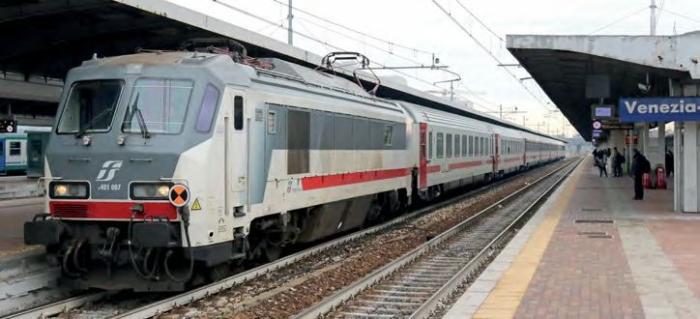
CLASS 401 REBUILT LOCOS IN SERVICE
No E 401 007 leaves Venezia Mestre on 19 December 2018 with an Intercity service to Rome. Italian national operator Trenitalia is converting its former Class 402A electric locos dating from 1992 to 1994 into single-ended power car style locos to be used on one end of a push-pull intercity train. The conversion process, undertaken by Trenitalia at its Foligno works, involves a full overhaul including removal of one cab and equipping for push-pull operation. Electronic systems for the refurbished locos are being supplied by CAF. By December 21 of the 40 locos to be converted had re-entered traffic. Keith Fender
LUXEMBOURG
FREE TRAVEL FOR ALL AND NEW TRAINS ORDERED
The new Luxembourg government has announced it will implement its election promise to abolish public transport fares within the country. This is likely to occur between the middle of this year and December.
Luxembourg city reportedly has some of the worst traffic congestion in Europe and the new government policy aims to encourage public transport usage, especially by the country’s 600,000 residents. Around 200,000 people commute into Luxembourg daily from neighbouring Germany, Belgium and France – many by car. The scale of the modal switch, and thus reduction in congestion, will partly depend on how many of the commuters from neighbouring countries choose to park near the border and take trains or buses.
Fares in Luxembourg are already very low, subsidised by tax revenues earned from the financial services industry based in the Duchy – an annual all-network rail and bus season ticket costs between €220 and €440 (and a national day ticket just €4). Fares are therefore unlikely to represent a serious barrier to using public transport, so their removal may not lead to substantial new passenger numbers, which have already seen growth of 70% since the turn of the century. Several other European cities have proposed removing fares for public transport, although none yet have, and these will be watching the Luxembourg experience carefully (most cities elsewhere currently charge significantly more than Luxembourg for annual season tickets so could expect more people to switch to save money).
In mid-December Luxembourg national operator CFL announced it had selected Alstom to build 34 new Coradia double deck trains in an order worth €350 million. The new fleet, which is primarily being bought to replace the 1990-built Class 2000 EMUs (based on the SNCF Z2 design), will include 80-metre and 160-metre-long trains to be delivered from December 2021 onwards; it will also provide additional capacity for passenger growth.
The 160km/h 25kV AC trains will be equipped with European Rail Traffic Management System (European Train Control System Level 2 Baseline 3) and TBL1+ signalling systems enabling operation in neighbouring Belgium and France on lines electrified at 25kV AC. CFL already operates a fleet of 22 older three-car Coradia double deck EMUs (Class 2200) built from 2005 onwards, plus a fleet of 19 Stadler-built three-car double deck Kiss EMUs, the latest of which are due for delivery in 2019. The new trains will be built at the Alstom plant in Barcelona with components from factories in France and Belgium. The new fleet is due for delivery between late 2021 and December 2024.
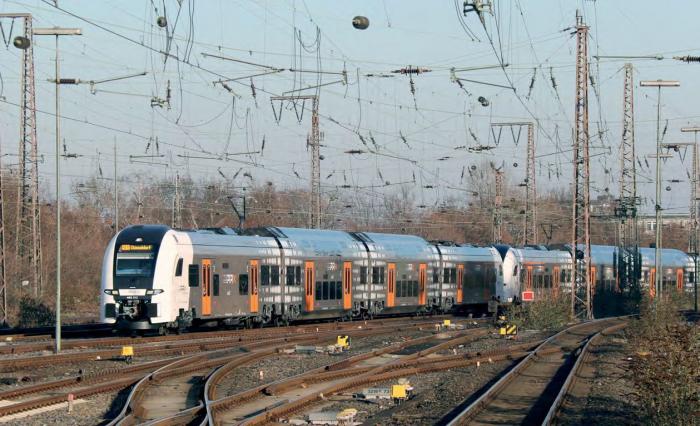
MOLDOVA
GE DIESELS FOR MOLDOVA
Moldovan state railway CFM has ordered 12 new ‘Evolution Series’ TE33A diesel locos from GE Transportation (similar to those supplied to Ukrainian operator UZ) in a contract valued at €45 million. The new locos, ordered to replace older Soviet-built diesel locos, utilise a 2,982kW GEVO engine; they will be built in the USA and delivered in 2020. CFM intends to use them operating both passenger and freight trains. Modernisation of maintenance depot facilities in the Moldovan capital Chișinău is included in the contract.
RUSSIA
HIGH-SPEED PROGRESS
Russian Railways (RZD) has announced that construction of the first 301km section east of Moscow of the proposed 770km high-speed line to Kazan will begin in 2019, led by a Russian-Chinese consortium working under a public-private partnership contract. The line between Zheleznodorozhny, around 30km east of central Moscow, and Gorokhovets, between the cities of Vladimir and Nizhny Novgorod, is due to open in 2024.
RZD has also announced plans to order 11 more new dual-voltage (3kV DC/25kV AC) Velaro-Rus ‘Sapsan’ high-speed trains from Siemens and its Russian partner the Sinara Group to add to its existing fleet of 16x10-car Velaro-Rus trains; as part of the contract these will be extended by one coach to 11-car sets from 2019 onwards.
It is unclear what trains will be used for the new Moscow – Kazan route; in 2016 Sinara agreed to establish a joint venture with Chinese firm CRRC to build up to 100 high-speed trains for the new route. In 2016 RZD and Chinese national railway operator China Railway Corporation also agreed to develop a ‘high-speed Moscow – Beijing International Transport Corridor’. The construction of the Moscow – Kazan high-speed line was identified by both operators as a priority first step to establishing a new international high-speed route connecting the two countries.
SWITZERLAND
TWINDEXX IC TRAINS ENTER SERVICE FIVE YEARS LATE
In June 2010 Swiss national operator SBB ordered 59 double deck ‘Twindexx’ EMUs from Bombardier. Designated SBB Class 502 with three variants for differing services, the trains were due to enter service between 2013 and 2019. Thanks to delays for a variety of reasons, including redesign for use in the Gotthard Base Tunnel (GBT) and a long-running legal dispute between SBB and organisations representing disabled people in Switzerland over access to and within the new trains, the delivery timescale was changed several times. As compensation for manufacturer related delay the order was increased to 62 trains, with three more being supplied free of charge.
The first train was accepted by SBB in February 2018 and limited passenger use began, but the fleet did not enter regular service until the December timetable change after full approval for use (initially limited to two years) was granted in mid-November. Initial entry into service was itself limited, with loco-hauled replacement trains frequently appearing in the weeks before Christmas. SBB plans to use the new trains on the following routes during 2019 replacing loco hauled trains: Intercity services (St Gallen – Zürich – Geneva); and Interregio services (Basel – Zürich and Zürich – Chur).
From 2020 all 62 Class 502 trains should be in service and the new trains will be used to replace ICN tilting EMUs on services between Ticino (Lugano/Bellinzona) and central Switzerland via the new GBT. The new GBT route does not require tilting trains to maintain schedules, unlike the old Gotthard mountain route – the ICN trains will be moved to routes where advantage can be taken of their tilt capability. Longer term, the Twindexx trains will be used for services into Germany and Austria; testing in both countries is underway.
TURKEY
HIGH-SPEED TRAIN DERAILS FOLLOWING COLLISION
Turkish Railways’ new Velaro high-speed train fleet suffered its first major accident on 13 December when the train forming the 06.30 Ankara to Konya YHT service collided head-on with an electric loco in Marşandiz, in the suburbs of Ankara. The first two vehicles of the Velaro, which was travelling at around 90km/h, were derailed, as was the Class E68000 electric loco it hit. The derailed Velaro vehicles struck the adjacent Marşandiz suburban station, leading to the collapse of a pedestrian overbridge on top of the derailed train. Three train crew and six passengers on the eight-car Velaro died at the scene or shortly afterwards, whilst another 84 were injured; 206 passengers were on the train.
The accident appears to have been caused by a signalling error or fault (it is currently unclear which); the electric loco had been despatched ahead of the high-speed train to ensure the line was clear of snow and the Velaro should have been on a different track. Following the accident, the leading trade union representing railway workers highlighted the fact that the 140km/h tracks used by YHT trains leaving Ankara westwards (connecting with the start of the high-speed line proper at Sincan, 24km from Ankara) are not fitted with a fully commissioned signalling system. Following the accident, three railway employees involved in signalling and controlling the trains were arrested and according to local media face charges of reckless manslaughter and causing injury.
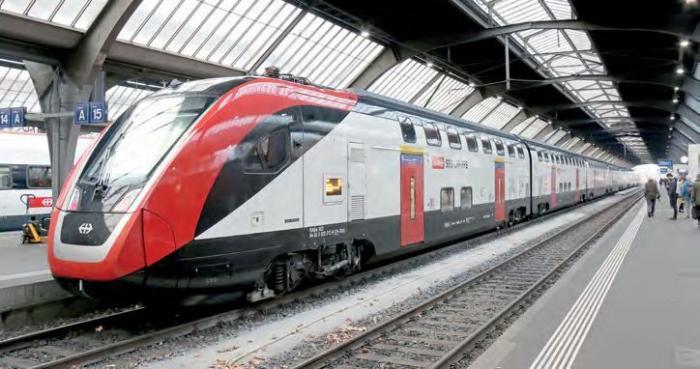
UKRAINE
UZ INTRODUCES THE TRIDENTS
The first of 30 new Class TE33A Co-Co diesel-electric locos for Ukrainian State Railways (UZ) entered service in late 2018. The locos, built by GE Transportation at Erie, Pennsylvania in the USA with some final assembly work being undertaken at the UZ Kryukov Works in Kremenchuk, are based on the TE33 design previously bought by Kazakhstan and use a 12-cylinder 3,355kW GE evolution series engine which meets EU Stage IIIB emissions rules. The long-term framework agreement between UZ and GE allows for up to 195 more locos to be supplied, potentially in kit form for final assembly, plus the refurbishment of existing locomotives and potentially long-term maintenance service contracts.
UZ has named the new loco type as the Tryzub (Trident) after the country’s post-Soviet coat of arms, which is based on much older predecessors. The new locos are designed for heavy freight to replace Soviet era designs dating from the 1970s/1980s. They will be used initially from Melitopol depot in southern Ukraine for freight traffic between Mariupol and Kherson. UZ expects the TE33A design will reduce significantly harmful emissions and fuel/ oil consumption whilst reducing maintenance costs compared to the fleet it will partly replace.
